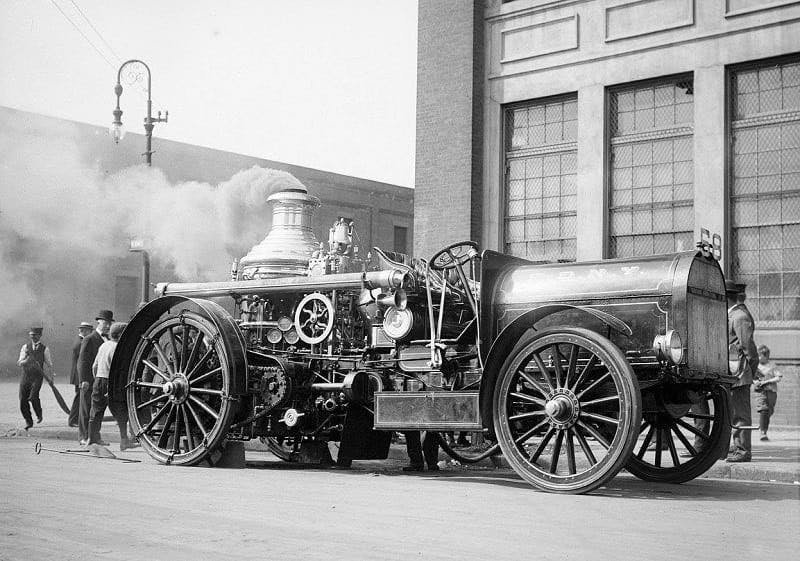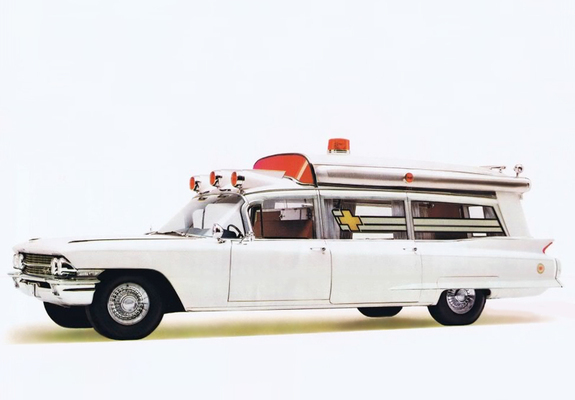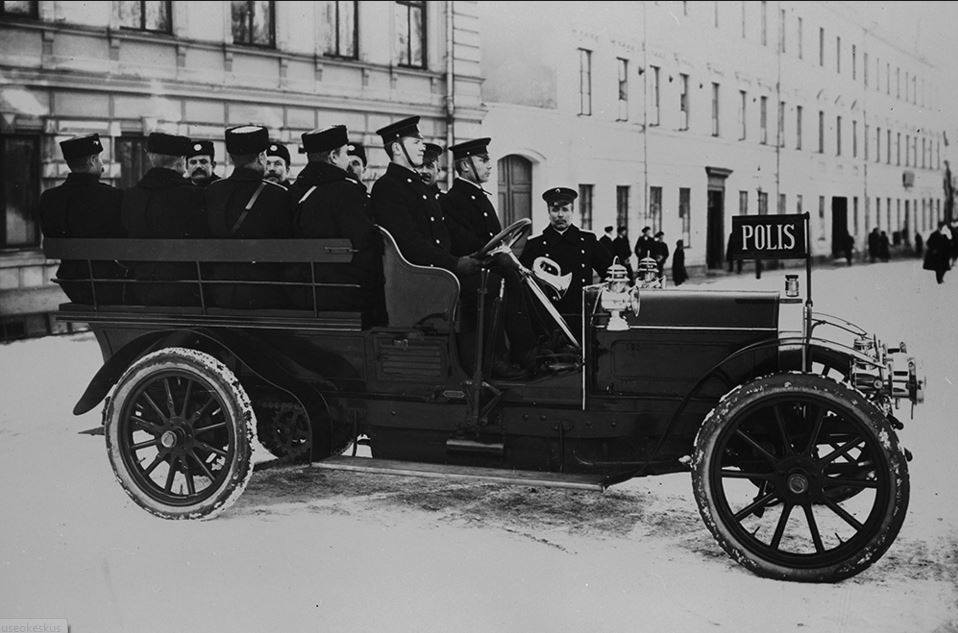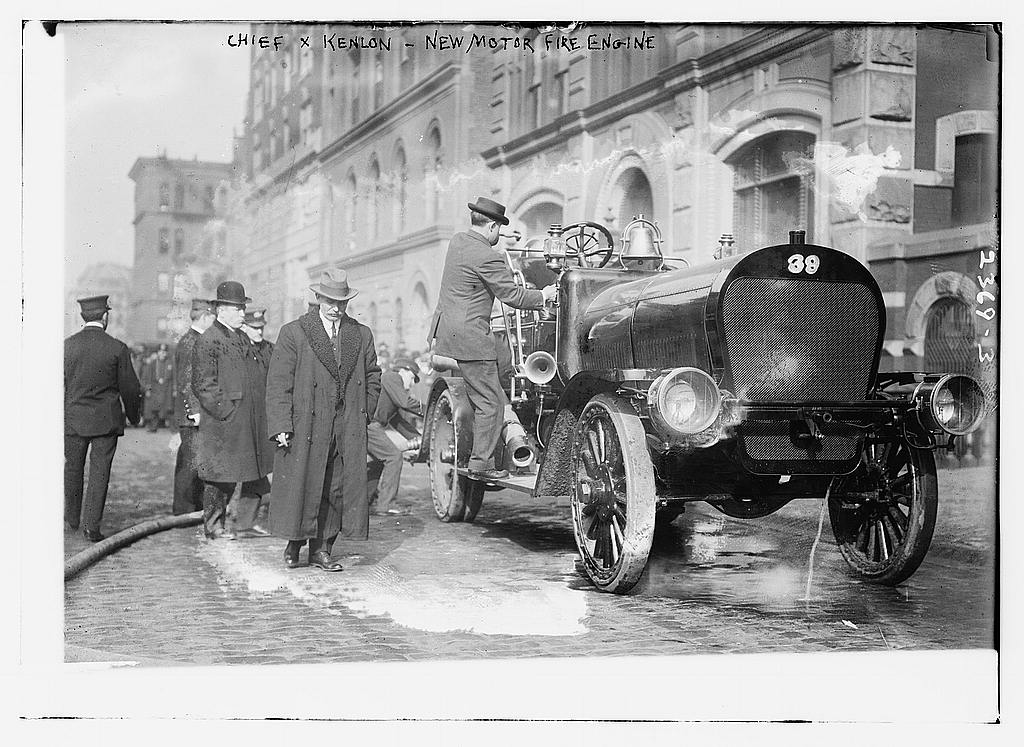About JC Whitney Editorial Team

Meet the JC Whitney Editorial Team, your go-to experts for automotive insights, from in-depth car culture articles to the latest in vehicle tech.
More from JC Whitney Editorial TeamIf you drive down any street or highway in America long enough you’re likely to encounter a first responder vehicle of one kind or another. Whether it’s a fire engine, an ambulance, or a police interceptor, these vehicles are put to work every day in some of the most high-pressure jobs around. But each one of these first responder vehicle types has undergone a long evolution going back to the days of horse and carriage all the way up to modern times. These vehicles are icons in their own right; their distinctive looks add to the mythology of the American road. Here is a brief guide to first responder vehicles.

Fire Engines
The evolution of fire engines reflects a fascinating journey of innovation, driven by the increasing needs of urban development, technological advancements, and the imperative to protect communities from the ravages of fire. From the pre-automobile days to the sophisticated apparatuses of modern times, each era’s fire-fighting vehicles were a response to the challenges of their times, marking significant milestones in the history of firefighting.
In the pre-automobile era, firefighting was a manual endeavor. The earliest “fire engines” were nothing more than hand-pumped devices mounted on carts, which firefighters pulled to the scene of a fire. These manual pumps required a team of men to operate, drawing water from a source and pumping it through hoses to douse the flames. Despite their rudimentary nature, these devices represented a significant step forward in organized firefighting, enabling a more directed and effective response to fires than the previously used bucket brigades.
As cities grew and the need for more efficient firefighting methods became apparent, horse-drawn steam pumper fire engines emerged in the 19th century. These engines, powered by steam, were capable of pumping water at much higher pressures and over longer distances than their manual predecessors. One notable model was the Amoskeag steam fire engine, produced by the Amoskeag Manufacturing Company in Manchester, New Hampshire. These steam-powered engines significantly improved firefighting capabilities but still required horses to pull them to the scene of a fire.
The advent of the automobile revolutionized many aspects of society, including firefighting. Motorized fire engines began to appear in the early 20th century, offering increased speed, reliability, and the ability to carry more equipment and water. The transition to motorized vehicles was gradual but marked a significant leap in firefighting efficiency. One of the early adopters of motorized fire engines was the Knox Automobile Company, which produced one of the first motorized fire trucks in the 1900s. These vehicles could respond to fires more quickly and effectively than horse-drawn apparatuses, marking the beginning of the modern era of firefighting.
Throughout the 20th century, fire engines evolved to become more specialized and technologically advanced. The introduction of ladder trucks, equipped with extendable ladders to reach high-rise buildings, and pumper trucks, designed to carry large volumes of water and pump it at high pressures, are examples of this specialization. Manufacturers like American LaFrance, Mack Trucks, and Seagrave were at the forefront of innovation, producing vehicles that set new standards for performance and reliability.
In the latter part of the 20th century and into the 21st century, fire engines have continued to evolve, incorporating advanced materials, electronic systems, and computer-aided design to improve performance, safety, and effectiveness. Modern fire engines are equipped with a range of specialized tools and equipment, including high-pressure hoses, hydraulic rescue tools, and thermal imaging cameras, to address a variety of emergency situations. Today’s fire engines, such as those produced by Pierce Manufacturing and Rosenbauer, represent the pinnacle of over two centuries of innovation, designed to meet the complex demands of contemporary firefighting and rescue operations. These fire engines typically feature powerful diesel engines, with some models using engines from Cummins or Detroit Diesel. The output of these engines can vary widely depending on the model and intended use, but it is not uncommon for them to range from 350 to over 600 horsepower, providing the necessary acceleration and torque for rapid response and heavy-duty tasks.
From the simple hand-pumped apparatuses of the pre-automobile era to the technologically advanced vehicles of today, the history of fire engines is a testament to human ingenuity and the ongoing commitment to protecting communities from fire. Each era’s advancements in firefighting vehicles have been a response to the challenges of the time, driven by technological advancements, urban development, and a deep-seated commitment to public safety.

Ambulances
The evolution of ambulances mirrors the broader trajectory of medical and technological advancements, reflecting society’s increasing emphasis on efficient emergency medical care. From the pre-automobile days to the sophisticated emergency vehicles of modern times, the development of ambulances has been shaped by the dual needs of rapid medical response and the effective treatment of patients during transport.
In the pre-automobile era, ambulances were essentially horse-drawn wagons, specifically designed or adapted for the transportation of the sick and injured. These early ambulances emerged prominently on the battlefields of the 19th century, where the need to quickly transport wounded soldiers to field hospitals became a critical aspect of military strategy. One notable early example was the ambulance volante used by Napoleon’s army, designed by Dominique Jean Larrey. These were light, horse-drawn vehicles, intended to rapidly collect the wounded from the battlefield.
With the advent of the automobile at the turn of the 20th century, motorized vehicles began to replace horse-drawn wagons, marking a significant leap forward in the efficiency and effectiveness of ambulances. Early motorized ambulances were often converted cars or vans, equipped with basic medical supplies and stretchers. In the United States, one of the first recorded uses of a motorized ambulance was by the Michael Reese Hospital in Chicago, in 1899, employing a converted electric car.
As automotive technology advanced, so too did ambulance design. During the early to mid-20th century, ambulances began to be custom-built on truck or van chassis, designed specifically for medical transport. This era saw the introduction of more sophisticated medical equipment onboard, including oxygen tanks, first aid supplies, and later, two-way radios for communication with hospitals. Manufacturers such as Cadillac and Ford became known for their ambulance models, with the Cadillac high-bodied ambulance of the 1950s and 1960s being particularly iconic in the United States.
The latter part of the 20th century saw further specialization and technological advancement in ambulance design. The introduction of advanced life support (ALS) ambulances equipped with defibrillators, advanced airway management tools, and intravenous therapy capabilities transformed ambulances into mobile treatment centers, capable of providing critical care en route to the hospital. This era also saw the standardization of ambulance design and equipment, with models like the Ford Type III ambulance becoming a common sight.
In modern times, ambulances have become highly sophisticated vehicles, incorporating the latest in medical technology and communications. Modern ambulances are equipped with electronic patient monitoring devices, GPS and navigation systems, and telemedicine capabilities, allowing for real-time communication with hospital staff. Manufacturers such as Mercedes-Benz, with their Sprinter model, and Ford, with their Transit model, offer platforms that are commonly converted into ambulances, known for their reliability, space, and ability to be customized to meet specific medical requirements.
From horse-drawn wagons on the battlefields of the 19th century to the high-tech mobile medical units of today, the history of ambulances is a story of continuous innovation and improvement. Each advancement in ambulance design has been driven by the imperative to save lives, demonstrating society’s commitment to providing rapid, effective medical care to those in need, wherever they may be.

Police Vehicles
The evolution of police cars is a fascinating journey that mirrors the broader history of automotive development and law enforcement practices. From the pre-automobile days to the technologically advanced units of modern times, police vehicles have evolved to meet the changing needs of public safety and law enforcement.
Before the advent of the automobile, law enforcement officers patrolled on foot or by horse. Horses provided a quick means of transport and an elevated view for officers, but their effectiveness was limited by distance and endurance. The introduction of bicycles in the late 19th century offered another method of patrol, especially in urban areas, allowing officers to cover more ground more quickly than on foot.
The early 20th century marked the beginning of the motorization of the police force. One of the first recorded uses of automobiles by police was in Akron, Ohio, in 1899, with an electric-powered buggy equipped with a gong and a stretcher. As automobiles became more common, police departments began to see the value of motor vehicles for rapid response and the pursuit of offenders. The Ford Model T, due to its affordability and reliability, became one of the first widely adopted police vehicles in the 1920s. Its versatility allowed for various modifications to suit police work, making it a staple in many departments.
The post-World War II era saw significant advancements in police vehicle design and technology. Police cars were equipped with more powerful engines to keep up with the faster automobiles that criminals used. The 1950s and 1960s saw the rise of iconic police cars like the Ford Crown Victoria in the United States, which became synonymous with law enforcement due to its durability, performance, and the ability to be outfitted with necessary police equipment. Similarly, in the UK, models like the Rover P6 were favored for their reliability and performance.
The late 20th and early 21st centuries have witnessed further specialization and technological advancement in police vehicles. Police departments have a variety of vehicles at their disposal, including SUVs and trucks, to meet specific operational needs such as off-road capability or additional equipment space. Modern police cars are not just about speed and performance; they are mobile offices equipped with advanced technology, including computers, GPS navigation, automatic license plate recognition systems, and in-car video systems. Vehicles like the Ford Police Interceptor Utility and the Chevrolet Tahoe Police Pursuit Vehicle are current examples, offering a blend of performance, space, and the ability to integrate advanced technology.
Moreover, the push towards sustainability has led to the introduction of hybrid and electric vehicles into police fleets. These vehicles offer the potential for reduced operational costs and lower emissions, aligning with broader environmental goals while still providing the performance needed for police work.
From horseback patrols to electric-powered police cars, the evolution of police vehicles reflects changes in technology, society, and the needs of law enforcement. Each era’s preferred models of police vehicles highlight the ongoing quest for more efficient, effective, and adaptable means of maintaining public safety and responding to emergencies.
